A few weeks ago Editor Duke introduced MO readers to Kawasaki’s new bludgeon for the Hayabusa, the incredibly potent 2012 ZX-14R. Just a couple of weeks later we’re bringing you another revamped sportbike from Team Green, the 2012 Ninja 650. Note to the recession from Kawasaki: Screw You!
In the process of overhauling the two machines, the Ninja 650’s “R” of the previous model was given to its big brother as designations have flip-flopped: from Ninja 650R to Ninja 650 and from ZX-14 to ZX-14R. The loss of the “R” nomenclature, though, hasn’t diminished the credentials of the more diminutive Ninja. In fact, Kawasaki claims to have improved the 650’s performance while maintaining its user-friendliness.
Unlike the bigger Ninja’s $1,100 price bump, the 2012 Ninja 650’s MSRP only increases $300 to $7,499. The new styling of the Ninja 650 is alone worthy of the price increase, making the technical modifications to the engine, suspension, chassis and gauges icing on this Ninja cake.
With cosmetic cues sourced from other Ninjas, the 650 enters 2012 in more aggressive fashion. Not only has each body part from headlight to tail light received beautification treatments, Kawasaki claims the changes also improve aerodynamics in terms of airflow and heat management. Impossible to truly gauge any engine heat issues on our cold-weather ride through rural San Diego County, I can report there was no comforting heat keeping me warm in the day’s waning temperatures, which should equate to minimal unwanted heat issues during warm weather riding.
Included in the cosmetic redesign is an adjustable windscreen with 60mm of vertical movement over three positions. However, instead of utilizing the convenient, lever-adjusted windscreen of the Ninja 1000, the 650 requires the removal of four bolts to reconfigure the screen. This obvious nod to cost cutting isn’t a deal breaker, and its adjustability at least offers positions to fit variously sized riders.
The rider and passenger seats boast wider seating areas and thicker foam, increasing seat height from 31.1 to 31.7 inches. The new double-pipe perimeter frame results in a 50mm-narrower midsection, helping bring a rider’s legs closer together when straddling the bike, thereby reducing the reach to the ground. A new fuel tank marginally increases capacity by 0.1 gallon to 4.2 gallons.
In the cockpit a new instrument cluster sees a change to a large, prominently placed analog tachometer with a digital interface below it with useful information including speed, a fuel gauge, current fuel consumption, average fuel consumption, remaining fuel range, clock, dual tripmeters and a high/low battery indicator.
Then there’s the ECO indicator — a measure of maximized MPG that equates to holding a steady throttle position in a higher gear. This useless information and wasted instrument real estate could have been better put to use displaying a gear-position indicator which Kawasaki failed to incorporate into the new Ninja.
The returning tubular handlebar is now 20mm wider, providing more leverage on a bike that probably didn’t need it but will benefit from the change nonetheless. To enhance its user-friendliness in urban situations, clutch effort is slightly reduced thanks to a new cable and slipperier lube. Adjustable clutch and brake levers are a convenient touch.
Parked among the stock models at the launch was a race-prepped Ninja 650 built by our friend Carry Andrew and HyperCycle that lent inspiration to what is possible. The profile of the Ninja 650 changes from sportbike to supersport by simply exchanging the superbike bars for clip-ons, likely also improving communication from the front end by doing away with the rubber-mounted stock bars that, while more upright and comfortable, dampen front-end feedback.
The narrower high-tensile steel twin-pipe perimeter frame complements the new steel twin-pipe swingarm. The chassis’ rigidity balance is said to be unchanged, the only real tweak being a solid rather than rubber rear engine mount. The addition of a protective plastic piece positioned between the frame tubes visually mars its otherwise eye-catching design. The new, slightly longer swingarm is attractive, especially its curvy right side, but the triangular left side looks more spindly.
A new subframe increases load capacity from 396 to 449 pounds, contributing to the Ninja’s 11-lb curb weight increase to 461, but the bike masks its weight incredibly well. Side-to-side transitions are quick, parking-lot maneuvers completed competently, and even when pushing the bike from here to there, we wouldn’t have guessed its weight had increased.
Suspension components, front and rear, feature new damping settings, reduced spring rates and increased length, the latter increasing travel to a generous 4.9 inches in front and 5.1 inches out back. The non-adjustable 41mm conventional fork is 5mm longer, with an unchanged rake of 25.0 degrees, while the longer-travel suspension increases trail from 4.17 inches to 4.33 inches. The rear shock is 2mm longer and also has a reduced spring rate for 2012.
Kawasaki claims the suspension changes optimize handling while increasing comfort. Such minor tweaks are difficult to confirm on a one-day ride without a comparative 2011 model, but we can confidently report that the Ninja maintains its easy-to-ride, non-intimidating reputation and offers a smoother ride than many other price-point bikes.
The Ninja is propelled by the same 649cc, liquid-cooled parallel-Twin featuring new pistons that decrease compression from 11.3:1 to 10.8:1. A redesigned airbox with rerouted inlets feed cooler air to the combustion chamber while a connector tube between the header pipes and a higher-volume, three-chamber muffler exhaust spent gases. The combination is claimed by Kawasaki to increase mid-range torque by 5% and increase fuel economy by approximately 10%.
Again, minor improvements, such as the aforementioned suspension changes, are difficult to substantiate, but the engine remains enjoyable and rev-happy – we’re told peak power remains constant, so expect about 60 horses at the rear wheel. Its new induction and exhaust systems add a slightly deeper and meaner sound. Despite the supposed increase in grunt below 7000 rpm, most of the Twin’s power is to be found closer to redline rather than in the basement.
The new Ninja rolls on Dunlop Roadsmart II tires, not to be confused with the Dunlop Sportmax Roadsmart II with the dual-compound rear tire recently reviewed by Pete Brissette. Wheel and tire sizes remain the same as last year: 120/70-17 front and 160/60-17 rear.
Kawi’s market research indicates the Ninja’s main rival to be Yamaha’s FZ6R, which retails for an extra $91. The four-cylinder Yamaha enjoys a slight advantage of peak horsepower, but the Ninja’s Twin has a power advantage everywhere below 8000 rpm. The Kawi is a friskier bike, while the FZ is slightly roomier for larger riders.
We’ll be better able to determine the benefits of the new Ninja 650’s tweaks once we have one in our possession for a longer period of time. For now, though, the affordably-priced Ninja remains a viable option to the more severe mid-displacement supersport models — which is exactly Kawasaki’s intention.
Related Reading
2010 Kawasaki Ninja 650 vs. 2009 Suzuki GSX650F vs. 2010 Yamaha FZ6R
2010 Kawasaki Ninja 650R Review
2011 250cc Beginner Bike Shootout
2009 Yamaha FZ6R Review
2012 Kawasaki ZX-14R Review [Video]
2010 Kawasaki Versys Review
 6:27 AM
6:27 AM
 Chiken Joe
Chiken Joe

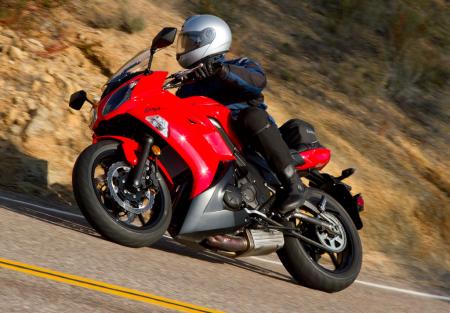
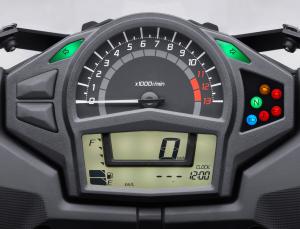
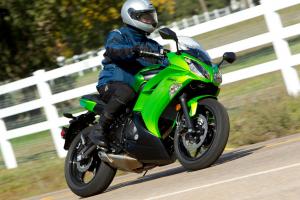
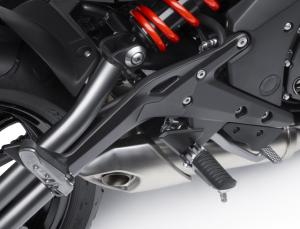
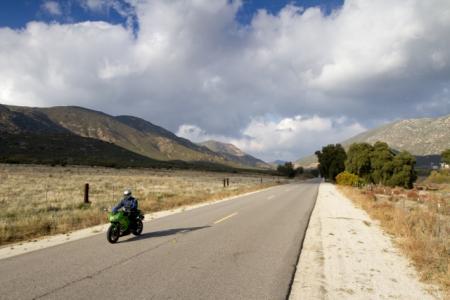
 Posted in:
Posted in: 







0 comments:
Post a Comment